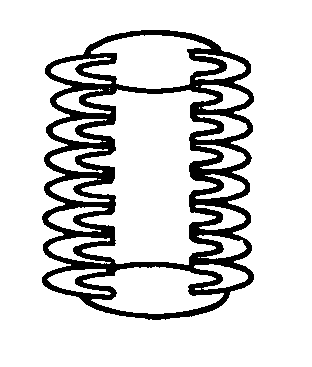Extensible and elastic conjugate fibers and webs having a nontacky feel
a technology of elastic conjugate fibers and webs, applied in the field of fibers and webs, can solve the problems of undesirable webs, limited use of traditional rubber and other textile elastic materials,
- Summary
- Abstract
- Description
- Claims
- Application Information
AI Technical Summary
Benefits of technology
Problems solved by technology
Method used
Image
Examples
example 1
[0088] For this example a bicomponent spinline available from Hills of Melbourne, Fla. was used which consisted of two spinpumps, one used for component A operated at 2.5 cubic centimeters per revolution and the second for component B operated at 6.4 cubic centimeters per revolution. Component A was fed from an extruder with four zones maintained at temperatures of 170° C., 200° C., 220° C., and 220° C. Component B was fed from an extruder having four zones maintained at temperatures of 180° C., 210° C., 230° C., and 230° C. The die had 144 holes at 0.65 mm diameter and 3.85 L / D and was maintained at 230° C. The pressure set point at the extruders was 750 psi, and the fiber speed was 1350 meters / min starting from 800 meters / min and ramped up in 30 seconds. Fibers were drawn using a Godet roll at the indicated speed. Three quench zones were used at 12° C., upper air flow of 0.2 m / sec, middle air flow of 0.28 m / sec, and lower air flow of 0.44 m / sec. A sheath core configuration was spu...
example 2
[0095] Using an arrangement generally as in FIG. 1, employing conditions 25 HPI pack, 390° F. melt temperature, 0.6 grams / hole / minute, fiber draw unit 4 psi, bond temperature of 150° F., calender roll wire weave pattern as described above, a spunbond web of about 1 osy (34 gsm) basis weight was produced (Table 3).
TABLE 3Peak1-CycleExtensionImmediatePeakΔHPASheath(%)Set (%)Load (lb)COFΔH(80° C.)Example(%)Core (%)CDMDCDMDCDMD(Web)(J / g)(%)C60—100PE342222419—2.27.92.1531492-110PE190PE329712535161.56.31.3538412-210PP190PE38512229263.37.51.4141352-310PE190PE213913140353.89.31.155443C70—100PE227816833263.38.62.174648C80—100PP17043——3.813.50.53——
[0096] The polypropylene sheath and plastomer sheath materials both demonstrated cloth-like feel, but the plastomer sheath embodiment of example 2-1 to 2-3 demonstrated both excellent elasticity and pleasing hand properties. In addition, using resins for both components with similar rates of crystallization and thermal behavior may provide process...
example 3
[0099] Using a Hills arrangement as described in Example 1, fibers with an effective heterophasic sheath were provided as indicated in the following Table 4:
TABLE 4DenierMeltSpinningperCore / TempThroughputSpeedFilamentΔHΔHPA (80° C.)ExampleSheathCoreSheath(° C.)(ghm)(m / min)(g / 9000 m)(J / g)(%)COFC9100 / 0 PE3——2200.620002.3029501.29C10100 / 0 PE3——2200.420002.0432481.283-0190 / 10PE340 / 60PE3 / PP12200.420001.833341—3-0290 / 10PE360 / 40PE3 / PP12200.420002.473443—3-0385 / 15PE340 / 60PE3 / PP12200.420001.7437371.093-0485 / 15PE360 / 40PE3 / PP12200.420001.7935400.963-0590 / 10CR20 / 80PE2 / PP12300.413501.605283—3-0690 / 10CR40 / 60PE2 / PP12300.413500.895285—3-0790 / 10CR40 / 60PE2 / PP12300.413501.855092—3-0890 / 10CR60 / 40PE2 / PP12300.413503.105487—3-0990 / 10CR60 / 40CR / PP12300.413503.105292—3-1090 / 10CR20 / 80CR / PP12300.413503.305384—3-1190 / 10PE320 / 80PE3 / RCP2300.420001.9429470.893-1290 / 10PE340 / 60PE3 / RCP2300.420001.682749—
[0100] Referring to FIG. 9, it can be seen that tensile responses for the sheaths of phase separated polymer blen...
PUM
| Property | Measurement | Unit |
|---|---|---|
| Fraction | aaaaa | aaaaa |
| Fraction | aaaaa | aaaaa |
| Fraction | aaaaa | aaaaa |
Abstract
Description
Claims
Application Information
 Login to View More
Login to View More - R&D
- Intellectual Property
- Life Sciences
- Materials
- Tech Scout
- Unparalleled Data Quality
- Higher Quality Content
- 60% Fewer Hallucinations
Browse by: Latest US Patents, China's latest patents, Technical Efficacy Thesaurus, Application Domain, Technology Topic, Popular Technical Reports.
© 2025 PatSnap. All rights reserved.Legal|Privacy policy|Modern Slavery Act Transparency Statement|Sitemap|About US| Contact US: help@patsnap.com



